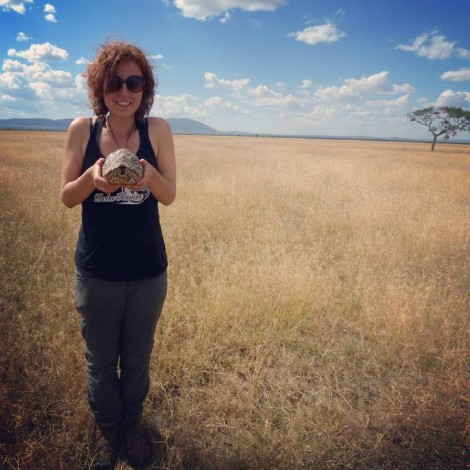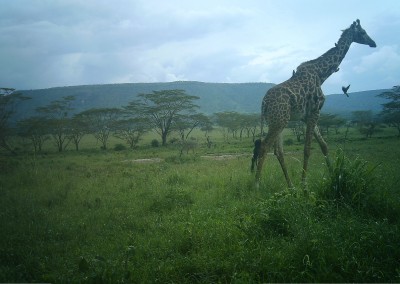
Giraffe Bed and Breakfasts?
Ohio Wesleyan Alumna Discusses Research in National Geographic
“Birds sleep in giraffe armpits, new photos reveal.” Wait – what?
That’s the headline of a recent National Geographic article featuring research conducted by 2011 Ohio Wesleyan University alumna Meredith Palmer, Ph.D. Now a postdoctoral research associate at the University of Minnesota, the former OWU zoology major’s work was included in the magazine’s February 27 “Weird and Wild” section.
In explaining her work, Palmer states on her blog: “My research takes me to eastern and southern Africa, where I study predator-prey dynamics in large mammalian communities. ... I use predator behavioral and demographic information we collect for the Serengeti Lion Project and camera trapping data and citizen science support from Snapshot Serengeti.”
And that’s where giraffe armpits come into the picture.
As National Geographic’s Joshua Rapp Learn reports, “Scientists have long known that yellow-billed oxpeckers hang out on massive African mammals like giraffe, water buffalo, and eland during the day … [b]ut a series of rare photos from a large multi-year camera trap study in Tanzania's Serengeti National Park have revealed that the birds actually roost on some of their hosts overnight.”
“You look at them on the giraffe and they’re just right up in there,” Palmer tells the reporter. “It’s a very safe, comfortable place for the birds.”

Palmer led a study on the phenomenon that was published February 16 in the African Journal of Ecology, widely considered the foremost research journal of its kind,the unique night photos.
The journal publication, titled “Giraffe bed and breakfast: Camera traps reveal Tanzanian yellow‐billed oxpeckers roosting on their large mammalian hosts,” was not Palmer’s first.
A previous Barry M. Goldwater Scholar and a National Science Foundation Graduate Research Fellowship recipient, Palmer began publishing research findings as an OWU undergraduate and has published two articles (to date) with OWU associate professor of zoology Shala Hankison, Ph.D.
“The opportunities provided at OWU have definitely paved the way for me, allowing me to make the most of my graduate career and my other research positions,” said Palmer, who currently has 14 journal articles published, in review, or in prep. “In particular, the mix of theoretical and practical trainings, the opportunities to write grants and conduct field work, and the fantastic and supportive array of professors (I can't go on enough about the amazing support provided by Drs. Shala Hankison, John Gatz, and Jed Burtt, among many others) all significantly shaped the scientist that I am today.”
Hankison, herself a 1995 OWU alumna, recalls Palmer as someone she knew was special right from the start.
“Meredith was the kind of student who was not only interested and engaged on her own, but who could bring a whole class with her,” Hankison said. “As a newer faculty at the time, I remember feeling lucky to work with her, because even as a student she seemed like a scientist who was going to do great things. I think her early successes, grants, scientific papers, and notice in the popular press have born that out already.
“Plus,” Hankison adds, “she is amazing in that ‘I-wish-I-could-take credit-but-she-was-amazing-and-I am-excited-that-I-got-to-work-with-her way.’ It was obvious even when I first met her that she was exceptional as a person, colleague, and friend.
Read more about Palmer’s research in National Geographic, Inside Science, and Popular Science. Learn more about Ohio Wesleyan’s zoology major.
